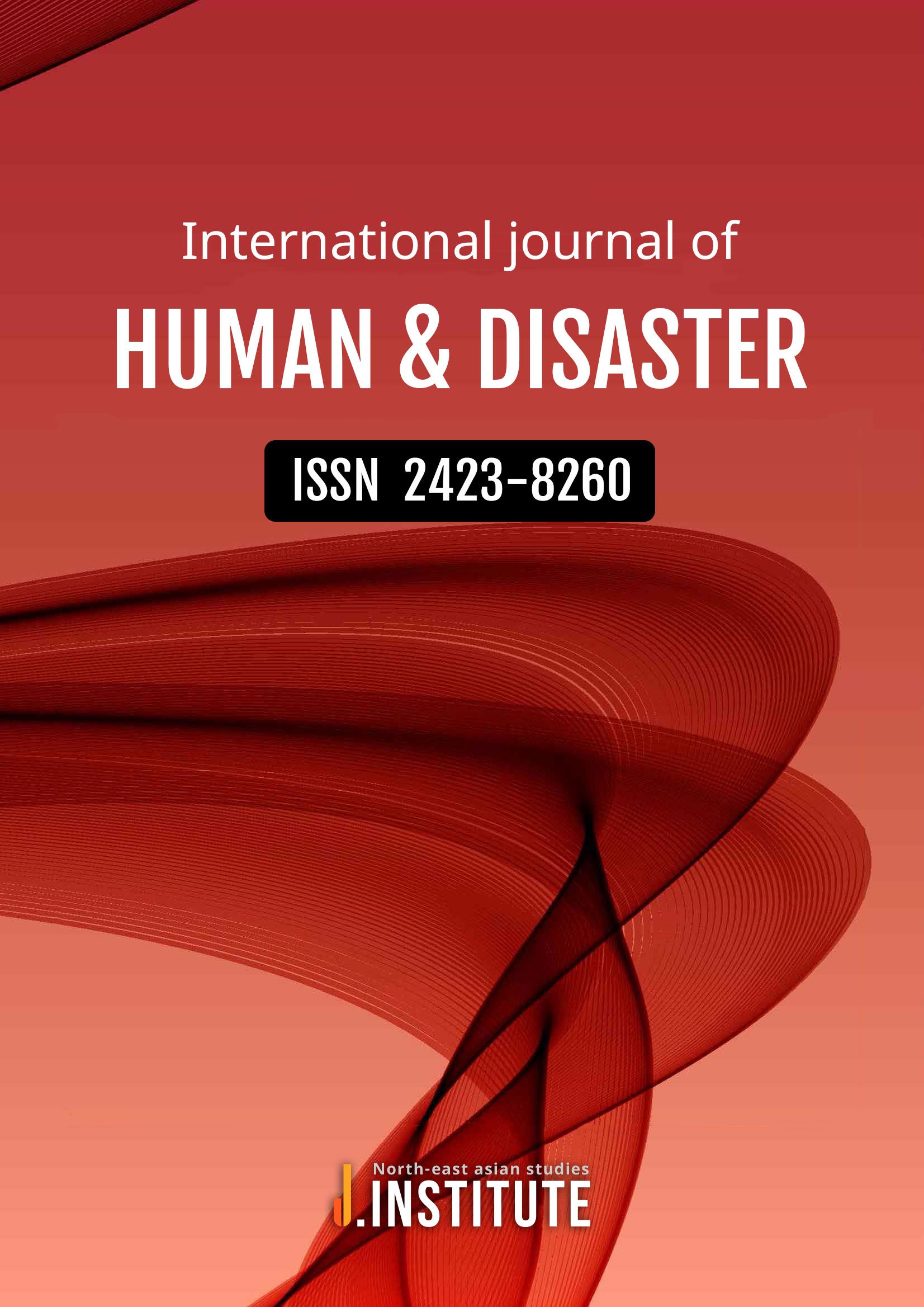Community interest in and demand for a safe society for humans, disasters, and peace of mind are increasing more rapidly. From this perspective, Humans and Disasters are closely related, and their impact on social values is interactive. The data on these things shows that understanding and respecting the importance of social values in disaster situations helps promote the resilience and sustainability of societies.
In the face of human catastrophe, social values are strengthening a sense of community, and forming a sense of solidarity as members of society become a culture, leading to moral choices about what individuals and groups value. Thus, culture and social values can provide creative ideas and approaches for problem-solving and new transformations in human life and behavior.
This journal looks at the diversifying social phenomenon from a human perspective, we want to take a reflective approach to reveal the story of the phenomenon as it is, and with deep interest in the problems of life. Has become a communication and it has grown into a shared, empathized, and communicated. Since the impact on human life is a problem that transcends borders, an international response is required, and research data are needed to achieve social balance by analyzing various phenomena that affect society through the improvement of human life quality. It not only reveals the existing phenomenon about the story within the phenomenon but also becomes a place where we can improve the problems of our lives and society, dealing with issues of social phenomena without prejudice, thinking about how society understands and what efforts to make.
Detail with a we recommend that potential authors review recent issues to determine whether their paper is appropriate to the journal.
Aims & Scope
Area 1 Human and Life
Area 2 Disaster
Area 3 Social Value
Latest Articles
-
Purpose: A large-scale complex disaster refers to a disaster that develops on a huge scale outside the predictable range as natural disasters and social disasters occur serially or simultaneously. The local community must take into account the diversity of residents' situations and organize an evacuation cooperation system in advance in order to respond to such large-scale, complex disasters. The purpose of this paper is to present a direction for improving community response to disasters through a review of large-scale complex disasters. Method: This study examines the large-scale flood damage evacuation plan in the 5th district of Koto, Tokyo, Japan, which established an evacuation plan led by the local community after the Great East Japan Earthquake. Evacuation was divided into vertical evacuation, evacuating within the community, and wide area evacuation, evacuating outside the community. Results: The main features of these evacuation plans were that they encouraged local residents to make independent judgements, to implement the plans, and to proactively request and prepare for administrative support for the parts that were insufficient. Conclusion: First of all, for efficient evacuation from large-scale-complex disasters, various stakeholders need to be recognized and systematically organize, and cooperation with relevant and upper-level administrative agencies is needed to solve problems that are beyond the capacity of local governments. It is also necessary for residents to recognize their own role in disaster response along with the proper implementation of disaster prevention administration, and for the administration to support factors that residents cannot do as much as possible, as the basic structure of the crisis.Keyword:Large-Scale Complex Disasters, Community-Driven, Correspondence of Administration, Disaster Response, Evacuation Plan
-
Purpose: The Kishida administration’s proposed Fukushima radioactive wastewater dumping plan is very controversial both domestically and internationally. This paper examines the risks and consequences of the plan with a special focus on human rights concerns. It argues that, as the Kishida administration commences the decommissioning of the Fukushima Daiichi Nuclear Power Station, it should only consider approaches that are consistent with a human-centric policy that is supportive of human rights. Method: This paper employs politics of responsibility theory to examine the Kishida administration’s proposed Fukushima radioactive wastewater dumping plan. In light of the current body of research on the decommissioning of the Fukushima Daiichi Nuclear Power Station by international scholars, scientists, and experts, it argues that the Kishida administration’s implementation of the proposed radioactive wastewater dumping plan represents a failure to govern with an eye to the politics of responsibility. Results: This paper finds that application of the Fukushima radioactive wastewater dumping plan under the Kishida administration will induce immense political, economic, social, and environmental consequences for Japanese citizens as well as citizens in neighboring countries and beyond. The Kishida administration is presently failing to pursue policies that reinforce a human-centric policy that would be more supportive of human rights. Conclusion: The Kishida administration must suspend the current plan to dump Fukushima’s radioactive wastewater into the Pacific Ocean and consider alternative methods that will not result in the radioactive pollution of the ocean. As it proceeds with the decommissioning of the Fukushima Daiichi Nuclear Power Station, it should focus on principles of governance emphasizing the politics of responsibility and take steps to abide by relevant international legal standards and human rights norms.Keyword:Kishida Administration, Fukushima Radioactive Wastewater Dumping Plan, Human Right to Health, The Politics of Responsibility, Protecting The Environment
-
Purpose: In this study, in order to find a way to minimize water supply shortage, reliability analysis of water supply was conducted by operating the Andong and the Imha Dam. The purpose is to find a way to minimize water shortage by the allocation distribution model from the reliability analysis results. Method: In this study, in order to analyze the water supply reliability of Andong and Imha Dam, using the Al-location rule presented by Park et al(2007), based on the planned water supply of Andong and Imha Dam for a total of 360 months from 1993 to 2022, analyzed. From the analysis results, the reliability of stable water supply was evaluated. Results: In the case of supplying the planned water supply of Andong and Imha Dam, the analysis result of Rule(B), which considers the ratio of the storage and inflow of the dam in the reservoir operation analysis result, showed that the shortage of Andong Dam occurred the most at 23 months, Regarding the number of shortages of control points, Rule(A), which considers only the storage capacity of the dam, was found to be short at 39 months, which is the largest number of shortages. As for the frequency standard reliability, Rule(B) showed the highest reliability of 90%, but in the case of quantitative reliability, the reliability was similar in all cases. Conclusion: In the water supply reliability, the reliability of stable water supply by supplying only the planned water supply amount is 94%, 93%, and 90% in Rule(B) of the allocation distribution model. 5% at the Andong dam, 7% at the Imha dam, and 10% at the control point. When water supply is evaluated with frequency reliability, it is judged that countermeasures for the shortfall are necessary. Next, in the case of quantitative reliability, when only the planned water supply was supplied, it was analyzed to be 95%, 94%, and 95% in all methods, so that the quantitative reliability was higher than the frequency reliability.Keyword:Water Disaster, Water Supply, Allocation Rule, Parallel Reservoir, Reliability
-
Purpose: This study examined the effects of smartphone addiction, parental attachment, and peer attachment on impulsivity among dropout adolescents, using 318 adolescents who participated in the fifth year of the Panel Survey of School Disengaged Adolescents. Method: To investigate the impact of smartphone addiction on impulsivity among school dropouts, we conducted inter-variable correlation analysis, three-step mediated regression analysis, and Sobel test. Results: First, the correlations between impulsivity, smartphone addiction, parental attachment, and peer attachment of dropout adolescents were analyzed, and the results showed that parental attachment and peer attachment were negatively related to impulsivity and smartphone addiction were positively related to impulsivity. Second, the mediating effects of parental attachment and peer attachment on the effects of smartphone addiction on impulsivity of dropout adolescents were analyzed, and the results showed that both parental attachment and peer attachment had mediating effects on reducing impulsivity of dropout adolescents. Conclusion: This study is significant in that it confirms the influence of parental attachment and peer attachment on smartphone addiction and impulsivity among dropout adolescents. Therefore, based on the findings of this study, various educational interventions are needed to reduce the impulsivity of dropout adolescents through various pathways of adolescent impulsivity, and at the same time, programs that promote healthy parent-child relationships and peer relationships should be actively implemented as a preventive measure.Keyword:Smartphone Addiction, Parental Attachment, Peer Attachment, Impulsivity, School-Disengaged Adolescents
-
Purpose: The Korean wave phenomenon is closely related to university students in Korea, and university students are greatly influenced by the Korean Wave phenomenon and experience and develop positive changes and opportunities through it. The Korean Wave phenomenon is contributing to university students introducing and promoting Korean wave contents abroad, contributing to Korean language education and cultural exchange, and becoming Korea's representative soft power factor through cultural event planning and international leadership. Through these roles, university students can gain opportunities to promote Korean culture and values to the world and form an international network, which has created a need for research on the lives of Korean university students. Method: In this study, 150 Korean university students were surveyed by convenience sampling method. A valid questionnaire was analyzed for 136 people, and the data were analyzed using the SPSS 23.0 program. Frequency analysis, t-test, and One Way ANOVA were used as analysis methods. According to the purpose of the analysis, differences in stress by gender, difference in organizational commitment by presence or absence of friends of the opposite sex, differences in empowerment by religious type, and differences in organizational commitment by friends of the opposite sex and dwelling type were explored. Results: First, as a result of examining the difference in stress according to gender in Korean university students, males answered Q7(I feel the need to reduce part of my role in my team) and Q8(I feel my role is too much in my team). It was found that women experience higher levels of stress than women. Second, as a result of verifying differences in empowerment according to religious types of Korean university students, in Q8(I decide the goal of my training by myself), the result was that Christian believers experienced higher empowerment than other religions(non-religious). And as a result of examining the difference in organizational commitment according to the presence or absence of friends of the opposite sex among Korean university students, those who have friends of the opposite sex were Q1(I feel a strong sense of belonging to the team I am currently training for), Q2(I think the current team is worth putting my heart and soul into), and Q3(I look forward to life in the team more positively in the future). Conclusion: First, Korean university students showed different role burdens and stress levels according to gender. Second, Christians tended to feel greater self-determination and control through religious values and belief systems. Third, those who have friends of the opposite sex tend to feel a strong sense of belonging and passion within the organization. Fourth, students living in university dormitory dormitories showed higher organizational commitment than students who commute to school. The university dormitory provides an environment that encourages the formation of relationships with classmates and communication with the outside world.Keyword:Korean Wave Culture, Korean University Students, Stress, Organizational Commitment, Empowerment
Publishing Schedule
| JAN | FEB | MAR | APR | MAY | JUN | JUL | AUG | SEP | OCT | NOV | DEC | |
|---|---|---|---|---|---|---|---|---|---|---|---|---|
| Submission | 4/30 | |||||||||||
| Editorial Review | 5/10 | |||||||||||
| Double Blind Peer Review | 5/30 | |||||||||||
| Review-Form Reflection Review | 6/10 | |||||||||||
| Accepted | 6/20 | |||||||||||
| Manuscript Editing Review | 6/30 | |||||||||||
| Scientific Proofreading | 7/30 | |||||||||||
| Open & Hybrid Review | 8/10 | |||||||||||
| Published | 8/30 |
♦ Issues Per Year: Annual
Organization / Board Members
Head of Editorial Organization / President
Chongsoo Cheung
Soongsil University, KOR
[Curriculum Vitae]
General Vice President
Kibum Park
Kyungil University, KOR
[Curriculum Vitae]
Vice President
| Dongkwan Lee Planning and Coordination | Joongbu University, KOR |
| Soonsun Park Public Relations | Masan University, KOR |
Editor in Chief
Gutaek Bae
Masan University, KOR
[Curriculum Vitae]
Executive Editor
Sunggeun Kim
Chungang University, KOR
[Curriculum Vitae]
Editor in Administrations
| Abu Musa Mohammad Arif Billah | University of Dhaka, Bangladesh |
| Changsoo Kim | Sungkyul University, KOR |
| Greggory J. Favre | University of Maryland, USA |
| Hyeoncheol Moon | Soongsil University, KOR |
| Jaeyong Woo | Nagano University, Japan |
| Jeongbin Choi | Air Force Leadership Center, KOR |
| Jeumnam Kim | Howon University, KOR |
| Kathryn Haynes | University of Wollongong Australia, Australia |
| Monthinee Teeramungcalanon | Peking University, China |
| Morales Ana | Florida International University, USA |
| Nandintsetseg Sosorbaram | Soongsil University, KOR |
| Seungbum Ryoo | Soongsil University, KOR |
History
| 2015 | ||
| JUN. 23 | National Tax Service of Republic of Korea (493-92-00207) | |
| DEC. 05 | Inaugural General Meeting | |
| 2016 | FEB. 19 | International Journal of Human & Disaster (ISSN 2423-8260) |
| JUN. 30 | First Journal Publication (Japan) | |
| OCT. 11 | Digital Object Identifier Enrollment (DOI) Google Scholar |
|
| 2019 | APR. 23 | EBSCO |
| APR. 30 | I2OR | |
| MAY. 07 | ProQuest Exribris |
|
| MAY. 15 | Infobase Index | |
| MAY. 31 | SIS | |
| 2020 | NOV. 02 | KCI (Korea Citation Index) |

Paper Submit
- inquiry@j-institute.org










